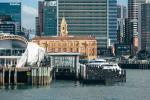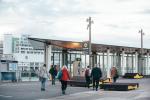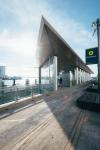Te Ngau o Horotiu — Downtown Ferry Terminal

Te Ngau o Horotiu is the biggest upgrade to Auckland’s ferry infrastructure and passenger services in more than 100 years. The Ferry Landing together with Te Wananga (the Downtown Public Space) forms the Downtown Ferry Basin Redevelopment project; Auckland’s most significant urban waterfront development where visitors arrive and are welcomed to Tamaki. The project responds to sea level rise and is designed to promote mode shift to more sustainable travel choices.
Located at the foot of Queen Street and bounded by Quay Street and Queens Wharf, the ferry basin is Auckland’s busiest stretch of waterfront. Over the next 10 years it is projected that there will be 8 times as many people using the area every day. The number of people travelling through the Ferry Terminal is expected to increase by up to 50% from the 6 million people a year that currently travel through it.
As the point of landing and leaving, the design explores the interface between land and sea, and has a uniquely Aotearoa response driven by kaupapa Maori principles of manaakitanga (hospitality), miharo (extraordinary), and transformation from “Auckland to Tamaki Makaurau”.
Attached to the western edge of Queens Wharf the new Ferry Terminal is designed to meet Auckland’s growing transport needs; the six additional berths will transform the way ferry services operate on the Waitemata Harbour. The architecture and infrastructure of the Ferry Terminal make a confident statement about Tamaki Makaurau and offer an enhanced user experience of arrival and departure.
With a mandate to create a future-proofed ferry network the new and upgraded infrastructure provides a dynamic place of arrival, departure and connection.
The design team worked collaboratively with Auckland Council, Auckland Transport, mana whenua partners and key stakeholders to create a destination rather than a thoroughfare; a place that offers improved accessibility and greater operational flexibility to accommodate increased passenger numbers.
The name Te Ngau o Horotiu was gifted by mana whenua and is derived from a number of kaupapa—“the Te wai o Horotiu is the awa that streams from a puna out of Myers park that flowed down queen street and into the Waitemata, the pier structure that is being built looks like the teeth of a Taniwha and this in turn lead to the name being suggested as “Te Ngau o Horotiu”. This also gives mana to the Awa and how it previously ran on top of the land and cut through the landscape to flow into the harbour. Although now it flows underground and is not known to many but this name will bring it back to life.”
—Zaelene Maxwell-Butler, Ngai Tai ki Tamaki
The existing piers 3 & 4 have been replaced by six new berths stretching along the western edge of Queens Wharf. People can now arrive and depart with ease via three spacious 6m wide gangways, which are sheltered from the weather by a cantilevered canopy structure. The gangways connect to six near identical floating pontoons that move with the tide.
To accommodate tidal fluctuations the Ferry Terminal rises and falls with the tide varying from a 4.4m clearance for the gangway at max high tide to an impressive 10m at max low tide. The 4m tall glass enclosure creates a space that is light, airy, and spacious. Custom details such as the manaia on the breakwater capping beam detail, the kaitiaki pile pattern and the etched pattern on the canopy soffit have been designed and developed by mana whenua appointed artists.
One of the project’s key design challenges was to deliver a civic response to the infrastructure requirements within a highly valued and congested public space. The design has delicately negotiated a balance between the existing and future requirements of various users, operators, owners, asset managers and stakeholders, in an environment that encompasses the environmental complexities of a coastal location, climate change, sea level rise, changes in weather patterns, and water quality. Important design considerations ranged from the pragmatics of vessel size, loading and manoeuvring, the art of passenger flow and management, the specifics of material selection in a marine environment, the scale of an appropriately civic response, a sensitivity to heritage.
This ambitious project was undertaken in a fast-tracked process to deliver to a hard deadline. To achieve these milestones, the team ran multiple work teams concurrently; these were coordinated through a leadership group that provided design management, client relationship management and tested the design back against key success criteria. Bringing a team of contractors on board early in the project to advise on technical, cost and programme matters ensured the project was reality checked against the real world and is completed on budget.
Off-site prefabrication of the pontoon and canopy elements enabled construction to progress on and off site in parallel speeding up the process and avoiding issues on a very constrained site. This has enabled the team to satisfy the client requirement to keep ferry services operations throughout the design, delivery and commissioning of the project.
The new Ferry Terminal represents a comprehensive revitalisation of the city centre’s land and water interface that seamlessly knits into the wider vision for Tamaki Makaurau that sees the transformation of the waterfront into an attractive, people friendly environment. Te Ngau o Horotiu was completed in July 2021.



